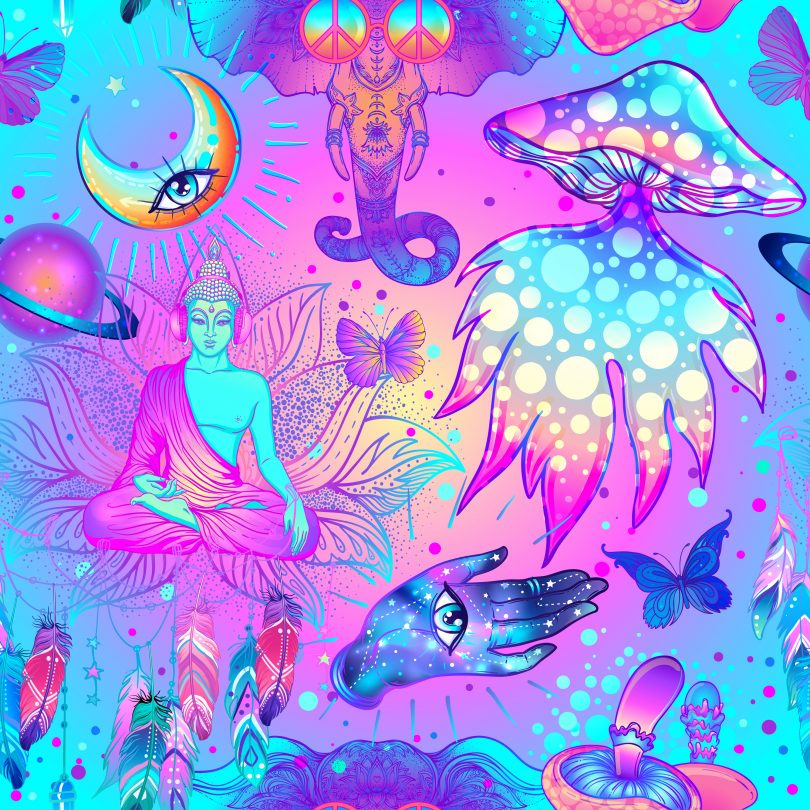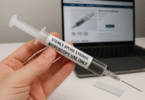DMT… few letters in the world of drugs have such an impressive following, reputations and devotion. Nicknamed the spirit substance due to its link to out of body experiences and incredibly strong trips, DMT is truly one of the most fascinating hallucinogens available, and one that deserves a thorough examination.
As part of our What Is (Drugs) series, examining different compounds and presenting their histories, effects and legality around the world, we’ve looked at a plethora of substances that can truly alter one’s experience. We will now look at DMT, perhaps best known for providing most intense trip a person can experience, but also for being the only known psychedelic substance to be naturally produced within the brain. So strap in as things get intense and we dive into the wonderful world of DMT.
What Is DMT?
Brittanica defines DMT, an abbreviation of its longer, chemical name Dimethyltryptamine, as a ‘powerful, naturally occurring hallucinogenic compound structurally related to the Drug LSD (lysergic acid diethylamide).’ It is the “naturally-occurring” part of this definition which is particularly interesting as DMT can be found in many plants and animals, including humans. DMT is a type of chemical called a tryptamine, a family of compounds that cause hallucinogenic experiences.
Another member of the Tryptamine family is Psilocin, found in magic mushrooms. Due to the fact that it can be produced by plants and is naturally occuring in the human body, DMT has a long historical connection with humans and has been used in Southern American countries for thousands of years in the plant based drink Ayahuasca, given at some shamanistic ceremonies. DMT can also be synthesised and produced artificially. In many European countries you are more likely to use synthetic DMT as fewer plants that produce it are grown there. DMT is known for giving users an intense and often spiritual trip that many have described as the most intense trip possible.
What Does It Look Like?
DMT can be consumed in a number of ways, but it cannot really be taken orally unless consumed in a mixture as Ayahuasca. Ayahuasca is a plant based mixture of which DMT is the main active ingredient. Apparently it tastes like cigarette butts and stale beer, so enjoy. Pure DMT is white and crystal like in its form but is often found as a yellowish powder or mixed with other substances. DMT can be smoked, snorted or injected. Regarding the smoking of DMT, it can either be vaporized as its pure substance, or smoked instead as a powder, often in its salt based form.
The History of DMT
DMT has been present within some cultures for many years, due to it being the main active ingredient in Ayahuasca. Ayahuasca has a long history associated with many South American tribes, including the Aztecs and a pouch containing the substance was found on an Aztec archaeological site dating back to over 1000 years ago. It was likely used in shamanic practices, allowing chosen members of the tribe to experience otherworldly connections with gods and spirits (an experience even users today may have on the drug).
In terms of modern use, the drug was first synthesised by a Chemist called Richard Manske in 1931. The hallucinogenic properties of the chemical weren’t discovered until the 1950’s when another chemist called Stephen Szará injected himself with DMT and experienced the first artificially created DMT high. The drug very quickly became illegal in the US, being listed as a Schedule 1 in 1970. This didn’t stop further research into DMT though, people began to find DMT produced by plants and trees and eventually a scientist called Rick Strassman began to formulate ideas about human genesis of DMT in the brain after finding the presence of DMT in rat brains.
‘Strassman became obsessed with the chemical, even going as far as to explain near death experiences as a bi-product of DMT production in the brain, supposedly coming from the pineal gland. DMT’s fame has risen considerably over the past few years and the intensity and spirituality of the highs it produces has made it one of the bucket list drugs for many psychedelic fans.
How Does It Feel?
There is no one way to describe a DMT trip, and indeed many users argue that words can;t do it justice. It is perhaps this complexity that makes the drug so compelling. Each person’s trip seems to be unique to them. The universal experiences seem to be a sense of euphoria, strong visual hallucinations, the feeling of floating and depersonalisation. The experience of a very strong DMT trip is described as ‘breaking through’ and is often accompanied with the feeling of moving through some kind of vortex, with fractal patterns and bright shapes.
Many people describe having intense encounters with ‘beings’ or ‘entities’ and having profound realisations and feelings of oneness. It all sounds quite incredible, but of course with all Psychedelics there is the risk of a bad trip. For some comprehensive accounts of DMT trips, good and bad, I highly recommend the youtube channel ‘Tales from the Trip’.
DMT & the Brain
DMT, like many other hallucinogens, affects Serotonin receptors. DMT has a very similar structure to Serotonin, a neurotransmitter that is linked to mood control, hunger and inhibition. What this means is that DMT will bind to serotonin receptors. DMT also seems to alter the waves that our brains produce, moving people into a biological altered state. Some psychologists actually hypothesise that humans can naturally produce DMT within there own brains. This is where things get kind of crazy.
DMT has been found to be potentially present inside human brains, suggesting that it is indeed produced naturally. Researchers began investigating this phenomenon after DMT was found to be present in the brains of dead rats. Locating exactly the amounts of DMT and indeed where it comes from is very tricky and lots of the research is preliminary, but still the idea that we have a naturally occurring source of one of the most powerful Hallucinogens in our own brains is quite incredible.
Positives
DMT is often described as the most intense tripping experience one can have, and for some people that’s already enough for them to hunt down their nearest supplier. The intensity of the stories people tell after tripping on DMT shows that if you want a profound, potentially life altering experience, this may be the drug for you. Another benefit is the relatively short amount of time it takes to wear off.
The effects supposedly wear off after 30-45 minutes, with many people saying that they feel completely sober as soon as the trip finishes, potentially even more clear minded than before. There also seems to be potential evidence of DMT’s therapeutic benefits, with a small dose of the drug possibly producing antidepressant effects in a sample of rats. This evidence, combined with anecdotal reports of the anti-depressant effects of DMT in humans, suggest a future avenue for research (though it must be re-stated, this is very preliminary evidence).
Negatives
Bad trips. Always the fear with any psychedelic, but particularly with one so powerful. A bad trip on DMT often includes: anxiety, feelings of paranoia and scary hallucinations that can feel as though they stay around for a while. Also, DMT can cause a very rapid increase in heart rate, which could be dangerous for someone with an already unstable heart-rate. Flashbacks as well can cause some users psychological stress, if they are reminded of a particularly bad situation. For all of these reasons above, it is essential that if you choose to use DMT you must do so in a safe, comfortable environment, surrounded by people you know and trust. With the right precautions, you can ensure a good DMT experience.
My Own Experiences
I personally haven’t ever tried DMT, but know of people who have and swear by it. It’s a drug that I am very keen to try one day, but know that I have to be in the right mindset and with the right people. Friends have told me stories of seeing great, god-like figures on their trips, which both fascinates and scares me. I am a skeptical man, but am always open to experiences that may change my attitude to life and perhaps DMT might be one of those experiences.
Conclusion
DMT is clearly an incredibly powerful drug with a reputation for spiritual and intense trips. If taken correctly it seems that an unforgettable almost life altering experience can be had. Of course, you must be cautious and certain that you want this type of experience before taking the drug, because there is no going back. The research around the potential of DMT’s synthesis in the brain is tantalising and may mean that taking the drug is the closest to a near death experience we can safely have.
I think it’s fitting to close with a quote by Rick Strassman, author of ‘The Spirit Molecule’ and one of the pioneers into DMT’s spiritual effects in the brain: “I thought I had died, and that I might not ever come back. I don’t know what happened. All of a sudden, BAM!, there I was. It was the most beautiful thing I’ve ever seen.”








Some things are sacred in a way where you should not just write about it before experiencing it.